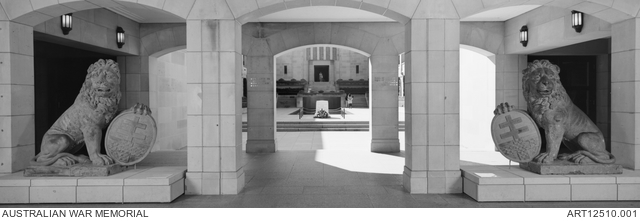| Places | |
|---|---|
| Accession Number | ART12510.001 |
| Collection type | Art |
| Measurement | Overall: 150 x 154.5 x 59 cm |
| Object type | Sculpture |
| Physical description | calcareous blue stone |
| Location | Main Bld: Commemorative Area |
| Maker |
Unknown |
| Place made | Belgium |
| Date made | c.1638-1700 |
| Conflict |
First World War, 1914-1918 |
| Copyright |
Item copyright: Copyright expired - public domain
|
Menin Gate lion



The Menin Gate lions were donated to the Commonwealth of Australia by the Burgomaster of Ypres in 1936. The lions each hold the Ypres Coat of Arms. The lions were given to the Australian government as a gesture of friendship. In exchange, in 1938, the Memorial gave a bronze casting of C. Web Gilbert’s sculpture Digger on behalf of the Australian government. The inscription on the casting of Digger reads: 'In assurance of a friendship that will not be forgotten even when the last digger has gone west and the last grave is crumbled'.
The lions are made of calcareous blue stone (sometimes also called 'little granite'), a blue-grey coloured stone from the provinces of Hainaut, Namur and Liege in Belgium. The stone is quarried exclusively in Belgium and is constituted from fossilised marine organisms. The stone used for the lions was probably quarried at Soignies, Belgium, where industrial extraction of the stone beginning in 1668. The exact date of the manufacture of the Menin Gate lions is debated. The earliest suggested date is in the 1500s, but most sources agree that a date between 1638 and 1700 is more likely.
The history of Menin Gate goes back to Louis XIV (1638-1715). He was responsible for the erection of ramparts around the city of Ypres. The walls around the city were pierced by two gates, one on the road to Lille being named the Lille Gate, the other the Menin Gate. In c.1830 the fortifications were modernised by the Dutch government and subsequently dismantled by the Belgian government in 1855-56. At this time, the Menin Gate lions were placed on brick plinths on either side of the Menin Road cutting where the Menin Gate once stood, an entrance to the medieval walled city of Ypres. It was through the Menin Gate that allied soldiers marched to the battlefields of the Ypres salient between 1914 and 1918. The 'Barrier Miner' (Broken Hill; 28/8/1936, p.3) newspaper noted; 'Through this historic gate during the war marched the great armies of the British Empire, France, the United States and Belgium, who fought in the battle of Ypres'. Similarly, the 'Adelaide News' (27/8/1936, p.9) notes; 'The Menin Gate was pulled down 80 years ago, but hundreds of thousands of allied troops, including many Australians, marched through the passageway in the ramparts during the great war'. After the First World War War, the Menin Gate was chosen as the site for a memorial, the Menin Gate Memorial to the Missing, dedicated to the British and Commonwealth soldiers who were killed in the Ypres Salient and whose graves are unknown. The memorial, designed by British architect Sir Archibald Blomfield, was unveiled on 24 July 1927 and consists of an imposing archway surmounted by a recumbent lion. It is inscribed with the names of 54,900 dead from Britain and Commonwealth countries.
Both Menin Gate lions were deeply chipped across their backs, and one had lost its right foreleg. The lions were chipped and damaged by shell fragments during the bombardment of Ypres during the First World War and when they arrived at the War Memorial, only one was in a suitable condition for display. The other had been badly damaged on one side of its head, and major damage elsewhere had reduced it to only a head and trunk ending just below the ribcage. When the lions arrived at the Memorial in September 1936, the building was not yet complete and lacked a suitable space to display them properly, although the lion with the missing leg was displayed by itself for several years. It was decided in 1985 to reconstruct the missing pieces of each lion in such a way that it would be obvious what was original and what was reconstructed. The reconstructed portions were designed so that they could be dismantled to return the sculptures to their original state, should that prove necessary. The work was done by Kasimiers L. Zywuszko, a Polish-born sculptor, with the assistance of period photographs obtained from Ypres. It was completed in 1987. The lions returned to display in 1991. After double checking the load-bearing capacity of the foyer floor, the lions were lifted by crane over the Memorial steps and placed inside the front entrance. All visitors now pass between the lions as they enter the building.
